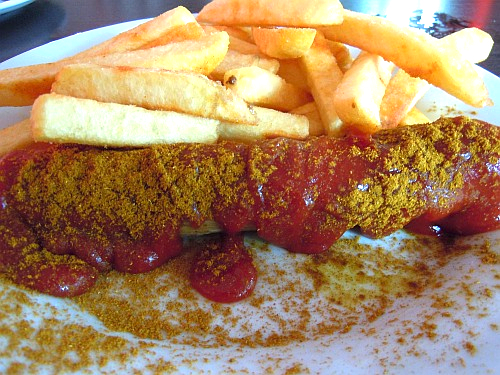Story and Photos by Sharon Hudgins
What could be more German than Currywurst: chunks of sausage slathered with a sauce based on the same ingredients as Anglo-American tomato ketchup spiced up with English Worcestershire sauce, Hungarian paprika, and Indian-inspired curry powder (by way of Britain), served with French fries on the side?
And now some Germans have added another multicultural twist: spiking the sauce with Caribbean and South American peppers, to stratospheric levels of Scoville Heat Units, as a challenge to macho munchers competing for the top-dog spot in their local Currywurst “Hall of Fame.”
From its humble origin as a street food in the country’s war-torn capital, Currywurst has risen to culinary cult status in Germany, even rating its own museum. That’s right: A museum devoted entirely to Currywurst opened in Berlin in 2009, on the dish’s 60th birthday, with exhibits on everything you always wanted to know about Currywurst (but didn’t know you wanted to ask).
Currywurst was invented in Berlin in 1949, when a woman named Herta Heuwer supposedly acquired some English curry powder (and possibly also Worcestershire sauce) from soldiers stationed in the British sector of the occupied city. Experimenting in her home kitchen, she concocted a tomato-based sauce as a topping for cooked sausages, which she sold at a street stand to construction workers rebuilding the rubble-strewn metropolis.
Heuwer’s Currywurst was such a success that she was soon able to open a small restaurant in the red-light district, which became a popular hangout for certain celebrities. In 1951, early in her career as the queen of Currywurst, she was also clever enough to patent the secret recipe for her seductive sauce, which she called “Chillup,” its name a contraction of “chilli” and “ketchup.”
Currywurst went on to take the country by storm. All over Germany street stands, festival stalls, food trucks, and even restaurants now sell their own versions of this simple dish. More than 800 million Currywursts are consumed annually in Germany—that’s nearly ten sauce-covered sausages for every man, woman, child, and foreign tourist in the country. But the sausages, sauces, and sides vary widely, not only from one region to another but also from one vendor to the next, even in the same neighborhood. Currywurst connoisseurs are well known for their unswerving loyalty to a particular Currywurst stand, disdaining all others as unworthy of their patronage. Claiming your favorite Currywurst stand as the “best” can quickly get you into a heated discussion at a German bar.

The recipe for Herta Heuwer’s original Currywurst sauce remains a secret, although many cooks have tried to replicate it. Some street vendors and restaurant chefs take pride in making their own signature sauce from scratch, refusing to reveal their personal recipes. Others take the easy way out by merely adding spices to bottled ketchup. And big companies such as Heinz and Knorr market a variety of “Curry Ketchups” in Germany. Just squeeze the bottle and squirt.
Most sauce recipes include curry powder and paprika, along with several other seasonings (take your pick): vinegar, sugar, garlic, onion, Worcestershire sauce, cinnamon, nutmeg, cloves, allspice, rosemary, bay leaf, black pepper, ginger, mace, mustard, fennel, anise, coriander, cardamom, cayenne pepper. The sausages are first simmered in water, broth, or beer, then finished on a griddle or grill, or pan-fried in a skillet. Usually they’re cut crosswise into pieces beore being covered with sauce. German engineers even invented a commercial cutter to slice the sausages in one whack, quickly and uniformly. (Cutting 800 million by hand just wouldn’t be efficient.)

Until recently, typical German Currywurst sauces tasted bland to confirmed chileheads, whatever their nationality. “Extra-hot” Currywurst just meant that slightly spicier curry powder was used, or maybe a few dried red pepper flakes were sprinkled over the top. But now the race is on—among some vendors, at least—to serve the hottest Currywurst sauce on the planet.
Eaten by everyone from proletarians to high-level politicians, Currywurst is particularly popular in its hometown of Berlin, where 70 million of these saucy sausages are sold every year. Many critics consider the Currywurst at Konnople’s Imbiss (two locations in Berlin) to be the best classic version in the city.
But a few years ago, two other stands, Curry 66 and Curry & Chili, upped the ante, both claiming to serve the hottest Currywurst in Berlin. Curry 66 has nine options, with their house-made #3 (Scharf, meaning “hot-spicy”) measuring 80,000 Scoville units and #9 (spiked with Black Death hot sauce) clocking in supposedly at 13,600,000. The vendor at Curry & Chili uses habaneros in his own house-made sauce and offers 12 heat levels. The top 10 are made with bottled hot sauces, ranging from Crazy Jerry at 11,000 Scovilles to Curry & Chili Gold Edition at a suspiciously even 7,777,777. The website posts photos of chileheads who’ve made it through all 10 top levels of heat, but the owner prudently refuses to serve those tongue-burners to children under the age of 18.
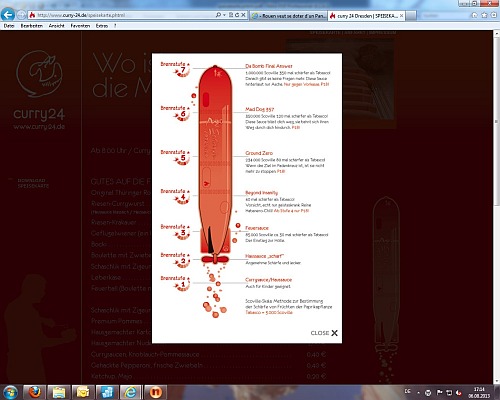
Hamburg is another hotbed of Currywurst consumption, with 72 million eaten annually in the Elbe port city, famous historically as a gateway for spices imported into Germany. And on a recent trip to Bremen, I sampled the top five levels of heat at Scharfrichter, a restaurant that specializes in Currywurst. The menu lists 10 levels of Scharf, with #5, named Kawumm, described as “bungee jumping for the tongue,” to #10, The Final Answer, tagged as “Blair’s disaster area,” whatever that means. Personally I preferred #7, hot enough to be interesting without overpowering the other flavors of the sauce.
At Scharfrichter, though, for an added price you can jack up the heat to levels 11-20, 21-30, and 31-40, burning out at 41. You can also get a card stamped every time you successfully move up to another level. But you have to sign a release if you want to go higher than 10. On Scharfrichter’s website, the Hall of Fame lists people who’ve even made it up to level 68, way off the scale offered on the menu.
The popular Curry 24 in Dresden advertises “the hottest Currywurst in the city,” with a clever sign in its windows and on the menu showing a red sausage “torpedo” with seven “burn levels” of propellant. Level #3, fiery Feuersauce, is a relatively friendly 85,000 Scovilles; #5, Ground Zero, registers 240,000; and #7, Da Bomb Final Answer, achieves maximum speed at 1,000,000 Scoville units. The owner says that he uses different liquid chile pepper concentrates to fuel his torpedo sauces—and sells over 250,000 Currywurst every year.
An exhibit at the Currywurst museum in Berlin showcases several varieties of this favorite German fast food, but doesn’t yet acknowledge the latest super-Scharf trend. The original West Berlin version is considered the classic Currywurst: a thick sausage (usually Bockwurst, sometimes Knockwurst) cut crosswise into chunks, topped with a red tomato-based sauce, garnished with curry powder, and served with a bread roll (Brötchen). The East German version uses skinless sausages, supposedly invented out of necessity when sausage skins were scarce in the early era of post-war rationing. In the Rhineland, Bratwurst is favored, doused with a thinner dark-red sauce (with the curry mixed in but not sprinkled on top) and served with French fries on the side.
 A “Manta plate” or “Schimanski plate” consists of Currywurst and French fries, with ketchup and mayonnaise dolloped on the spuds. (In Cologne and Düsseldorf the same combo is called a “white trash plate,” whereas in Hannover it’s “the Chancellor’s plate.” Go figure.) And a “taxi plate” is a caloric triumph of multiculturalism: Currywurst with French fries, barbecue sauce, and mayonnaise, plus Greek gyros (thin slices of spit-roasted meat) and tzatziki (yoghurt-cucumber-garlic sauce).
A “Manta plate” or “Schimanski plate” consists of Currywurst and French fries, with ketchup and mayonnaise dolloped on the spuds. (In Cologne and Düsseldorf the same combo is called a “white trash plate,” whereas in Hannover it’s “the Chancellor’s plate.” Go figure.) And a “taxi plate” is a caloric triumph of multiculturalism: Currywurst with French fries, barbecue sauce, and mayonnaise, plus Greek gyros (thin slices of spit-roasted meat) and tzatziki (yoghurt-cucumber-garlic sauce).
There’s even a “Luxus” version (“for those very special moments in life”), a prime example of Berlin ironic humor: a whole sausage with a piece of gold leaf draped over the top, surrounded by a pool of Currywurst sauce on a white china plate and accompanied by a glass of Sekt (German sparkling wine). And at Aqua, the Michelin 3-star restaurant in the Ritz-Carlton Hotel in Wolfsburg, I was served a cute little dessert amuse-bouche consisting of marzipan “sausages” wedged between macaroon “buns,” garnished with red strawberry sauce and sprinkled with cinnamon—the ultimate Currywurst haute dog.
Historically, though, Currywurst was (and still is) just a simple, inexpensive take-away food, most often bought at a Schnellimbiss or Currywurstbude (fast-food stand) and eaten while standing up. (Even McDonald’s felt compelled to add “McCurry Wurst” to its menu in Germany, with separate packets of Mild and Scharf curry powder for sprinkling on top.) Currywurst traditionally comes in an oval-shaped white cardboard bowl, along with a little wooden or plastic fork and a small white paper napkin for blotting up the messy drips of sauce—although some eat-in restaurants serve the sausages on a plate.
But even this humble fare possesses the power to inspire not only cooks, inventors, and museum curators, but also singers, writers, and artists. Currywurst is featured regularly on a German TV series, and in 2009 it was the subject of a cartoon contest on the Internet (http://blog.toonpool.com/cartoons/currywurst-cartoon-contest/). Currywurst has its own page on Facebook, and you can listen to “The Currywurst Song” on both Facebook and YouTube (although why you’d want to is another matter). But you might get a bigger kick out of watching some of the killer-Currywurst eating contests posted online—that is, if you get turned on by red-faced men with bulging tongues and tears streaming down their cheeks, stuffing themselves with German sausages.
How could such a simple, inexpensive, and common street food produce so much passion? Taste it yourself and see!
(The Deutsches Currywurst Museum is located on Schützenstrasse 70, 10117 Berlin, close to historic Checkpoint Charlie; www.currywurstmuseum.de)
Quick Currywurst Sauce
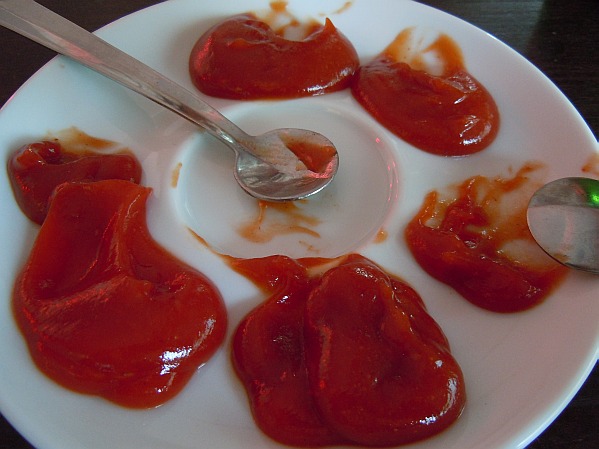
One taste of this ketchup-based sauce will instantly bring back memories of every Currywurst you’ve eaten at fast-food stands in Germany.
2 cups tomato ketchup (such as standard Heinz Tomato Ketchup)
3 tablespoons mild curry powder
2 teaspoons Hungarian hot paprika
1/8 teaspoon dry mustard powder
1/8 teaspoon ground ginger
Pinch of salt
1 teaspoon cider vinegar
1 to 2 tablespoons water
Garnish: Curry powder (mild, medium, or hot, to taste)
Combine all the ingredients (except water and the curry powder garnish) in a small saucepan. Cook over medium heat, stirring constantly, until the mixture is hot. Thin the sauce to the consistency you want, with 1 or 2 tablespoons of water, and continue heating and stirring until the mixture is hot.
Serve hot, spooning 2 to 3 tablespoons of sauce over each portion of cooked sausages cut crosswise into 1-inch pieces. Garnish with a generous sprinkling of curry powder. French fries or a bread roll are the classic accompaniments.
Makes 2 cups (10 to 16 servings). Refrigerate leftover sauce.
Homemade Currywurst Sauce
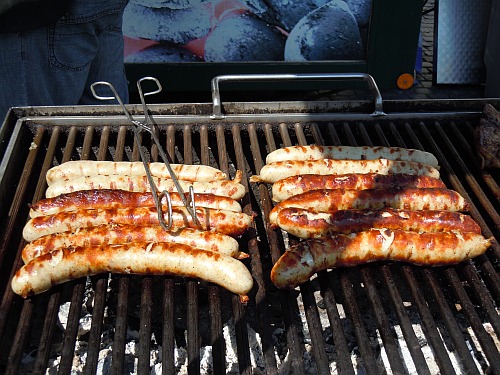
Start with this easy recipe for making Currywurst sauce “from scratch,” then tweak it according to your own taste. This recipe makes a thick, mildly spicy, rust-orange colored sauce, like some of those served over Currywurst in the southwestern part of Germany.
2 tablespoons canola oil
1 medium onion, finely chopped
1/4 cup mild curry powder
1 tablespoon Hungarian hot paprika
2 cups crushed red tomatoes, with their juice
2 tablespoons tomato paste
2 tablespoons apple cider vinegar
2 to 3 tablespoons sugar
1/4 teaspoon dry mustard powder
1/8 teaspoon powdered ginger
1/8 teaspoon ground cayenne pepper
1/8 teaspoon finely ground black pepper
1/8 teaspoon salt
Garnish: Curry powder (mild, medium, or hot, to taste)
Heat the oil in a medium saucepan over medium heat. Add the onion and cook, stirring frequently, for about 15 minutes. Sprinkle the curry powder and paprika over the onion and cook, stirring constantly, for only 1 minute. Quickly stir in the tomatoes, then add the tomato paste. Add all the remaining ingredients (except the curry powder garnish). Stir well, increase the heat to high, and bring the mixture to a boil, stirring constantly. Then reduce the heat to medium-low or low, just enough to keep the sauce simmering, for 20 minutes. Stir occasionally to keep the sauce from burning.
Let the sauce cool in the pan for a few minutes, then purée it very well in a blender. (For a finer texture, press it through a sieve after puréeing.) Return the sauce to the pan to reheat before serving. The sauce should be the consistency of tomato ketchup. If you need to thin it out a bit, add some water, 1 tablespoon at a time, as the sauce reheats.
Serve hot, spooning 2 to 3 tablespoons of sauce over each portion of cooked sausages cut crosswise into 1-inch pieces. Garnish with a generous sprinkling of curry powder. French fries or a bread roll are the classic accompaniments.
Makes 2 cups (10 to 16 servings). Refrigerate leftover sauce.
Fiery Currywurst Sauce Sauce
 Sure, you can spike some tomato ketchup with the hottest bottled sauce in your panty, dump it over a cooked sausage, shake some curry powder over it, and call it Currywurst: Scharf. Or you can make this fiery sauce with a somewhat fruity flavor as well as kick—sort of like a karate chop to the back of your throat, from a pretty woman with a smile on her face.
Sure, you can spike some tomato ketchup with the hottest bottled sauce in your panty, dump it over a cooked sausage, shake some curry powder over it, and call it Currywurst: Scharf. Or you can make this fiery sauce with a somewhat fruity flavor as well as kick—sort of like a karate chop to the back of your throat, from a pretty woman with a smile on her face.
IMPORTANT: Chop and measure all ingredients before you begin cooking. Be careful when working with habanero peppers. Wear disposable plastic gloves while chopping the peppers, and don’t touch your eyes. Clean your cutting board and knife thoroughly afterward.
WARNING: Don’t let the deep-orange color of this spicy sauce fool you. It’s not as hot as the top Scoville scorchers concocted for killer Currywursts in Germany, but it does have a lingering burn in the mouth. Do not serve it to children!
2 tablespoons canola oil
1 medium onion, finely chopped
1/2 large red bell pepper, finely chopped
6 to 8 orange or red habanero peppers, seeded and finely chopped
2 tablespoons Hungarian hot paprika
1 tablespoon ground cayenne pepper
2 cups crushed red tomatoes, with their juice
2 tablespoons tomato paste
1/2 cup water
3 tablespoons red wine vinegar
1/8 teaspoon salt
Garnish: Hot curry powder
Heat the oil in a medium saucepan over medium heat. Add the onion and bell pepper and cook, stirring frequently, for 10 minutes. Turn on the exhaust fan over your stove, add the habaneros to the pan, and cook, stirring frequently, for 5 more minutes. Sprinkle the paprika and cayenne over the onion and cook, stirring constantly, for only 1 minute. Quickly stir in the tomatoes, then add the tomato paste, water, vinegar, and salt. Stir well, increase the heat to high, and bring the mixture to a boil, stirring constantly. Then reduce the heat to medium-low or low, just enough to keep the sauce simmering, for 10 minutes. Stir occasionally.
Let the sauce cool slightly, then liquify it in a blender. Return it to the pan to reheat before serving. The finished sauce should be the consistency of tomato ketchup.
Serve hot, spooning 2 to 3 tablespoons of sauce over each portion of cooked sausages cut crosswise into 1-inch pieces. To get the right flavor profile for Scharf Currywurst, you also need to garnish with a good sprinkling of hot curry powder. French fries or a bread roll are the classic accompaniments.
Makes 3 cups, which is probably more than you’ll need unless you’re feeding a chilehead crowd. Refrigerate leftover sauce.
NOTE: For an even hotter sauce, purée the raw chopped habaneros with the mixture in the blender, instead of cooking them with the other ingredients.
Sharon Hudgins is the food columnist for German Life magazine (USA) and the Food Editor of European Traveler website. See more of her food and travel articles, with recipes, at www.sharonhudgins.com.
Comment from Harald Zoschke in Kressbronn, Germany
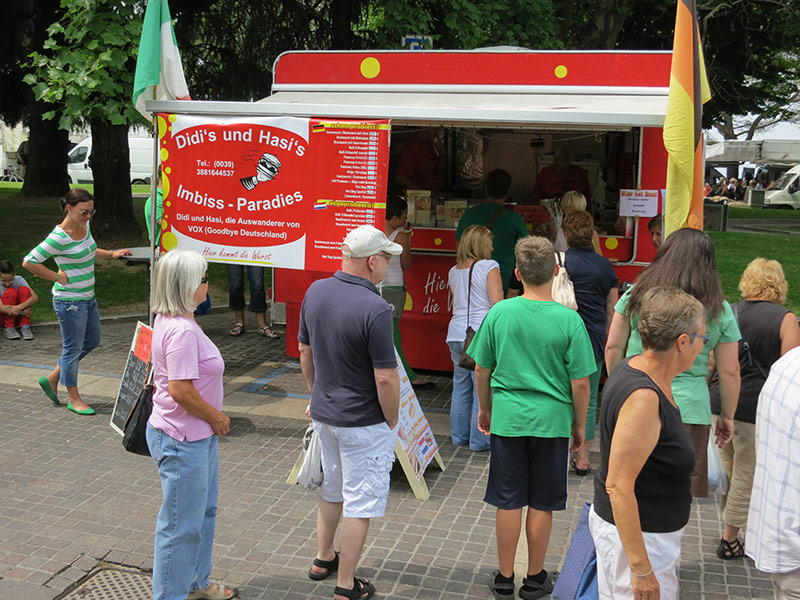 There’s a couple that was brave enough to take the concept of a currywurst stand to Italy, of all places! Anke und Dirk Leithäuser from Wermelskirchen (not far from Cologne) had the dream of living and working at the beautiful Garda Lake. They spent 25 years of camping vacation at the northern Italian Lake and figured how many fellow Germans did the same. So eventually they figured they could supply typical German food to them. They put all their money in a trailer that they had painted signal-red, dressed up in red and started offering currywurst, french fries and other German fast food classics at local markets around the lake. Since they started with little experience, they had to overcome all sorts of obstacles, from market officials to police and all sorts of red tape. But they were tough, didn’t give up, and just recently, they celebrated their 5th anniversary with their tasty business. They benefited a lot from German TV coverage in a series “Goodbye Deutschland”, reporting about emigrating Germans, trying to make it in foreign countries.
There’s a couple that was brave enough to take the concept of a currywurst stand to Italy, of all places! Anke und Dirk Leithäuser from Wermelskirchen (not far from Cologne) had the dream of living and working at the beautiful Garda Lake. They spent 25 years of camping vacation at the northern Italian Lake and figured how many fellow Germans did the same. So eventually they figured they could supply typical German food to them. They put all their money in a trailer that they had painted signal-red, dressed up in red and started offering currywurst, french fries and other German fast food classics at local markets around the lake. Since they started with little experience, they had to overcome all sorts of obstacles, from market officials to police and all sorts of red tape. But they were tough, didn’t give up, and just recently, they celebrated their 5th anniversary with their tasty business. They benefited a lot from German TV coverage in a series “Goodbye Deutschland”, reporting about emigrating Germans, trying to make it in foreign countries.
A few months ago we paid their trailer a visit, and it was nice to see that business was humming. See pic. Dirk’s and Anke’s nicknames are Didi and Hasi, and that’s what they called their business – “Didi’s and Hasi’s Imbiss-Paradies.”
They even have a Website: http://www.didiundhasi.com
Here’s their “Currywurst & Dolce Vita” facebook fan page: https://www.facebook.com/CurrywurstundDolceVita

